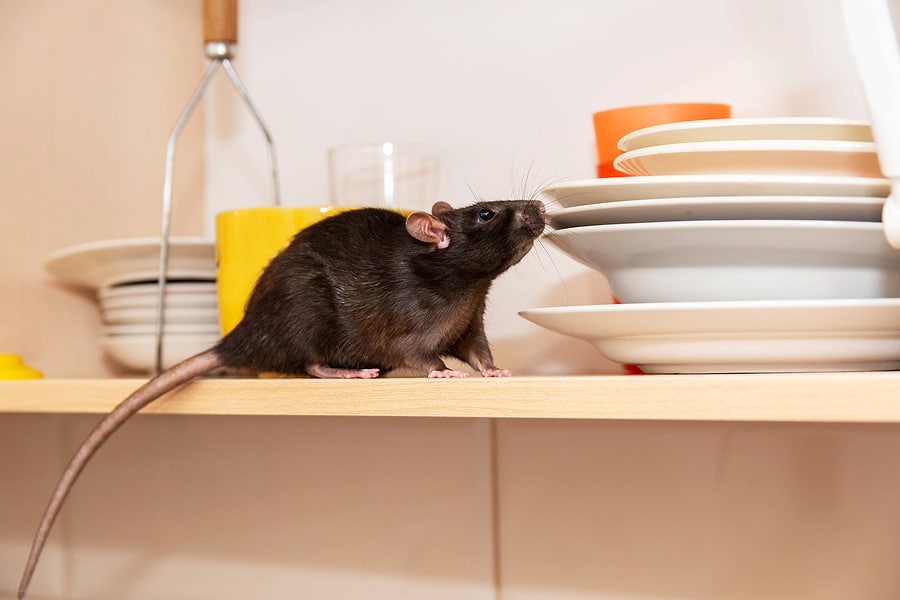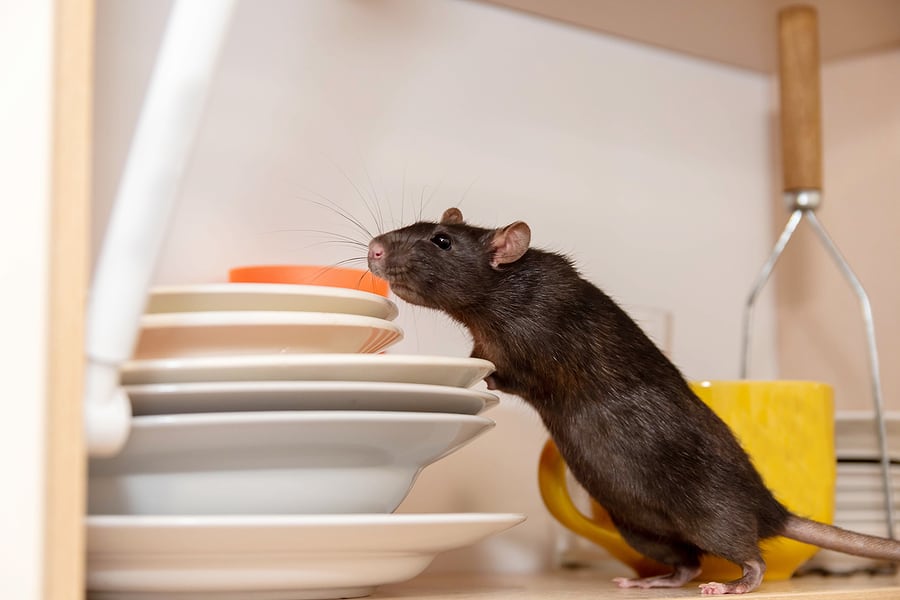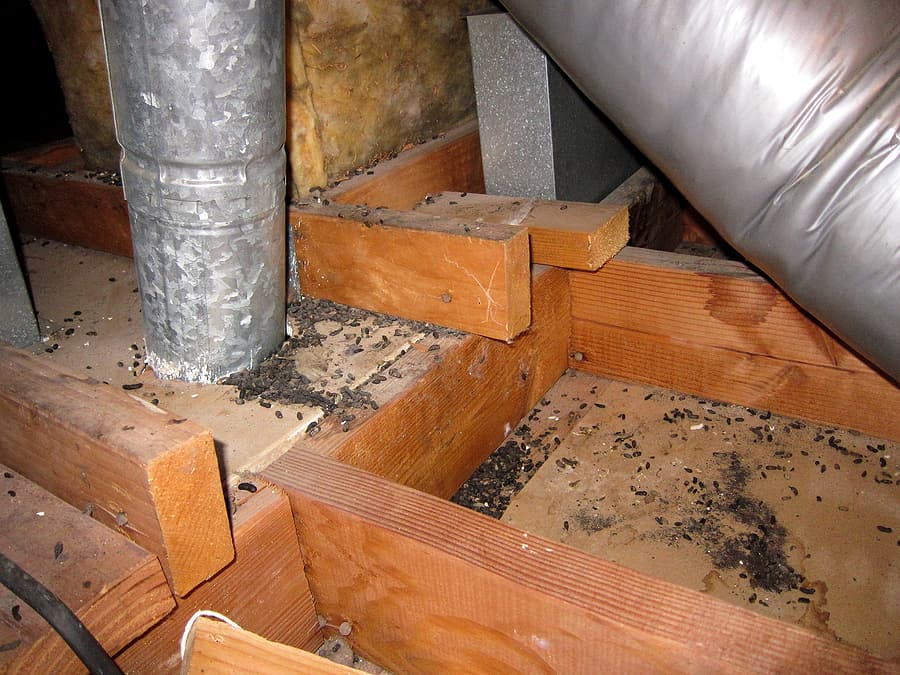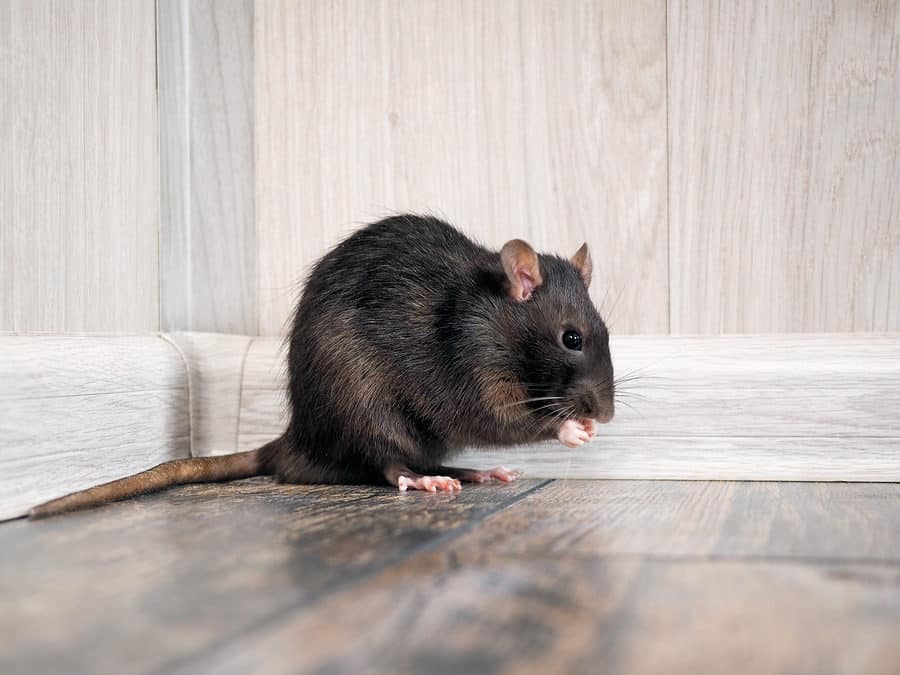READY TO GET STARTED?
REQUEST A FREE ESTIMATE
Fill out the form below or call (888) 466-7849 for a free, no-obligation estimate.

Rats are one of the most destructive household pests, chewing through wires, walls, and insulation and contaminating your home with their feces and urine. They also carry some pretty serious diseases, putting both you and your family at risk. These risk factors make identification and rodent control an important part of your household pest control plan.
Rats are mostly nocturnal pests and it is rare for them to come out during the day. Their activity typically begins around dusk. Because rats commonly inhabit areas near humans, it is safer for them to come out after dark when there is less chance of them being caught. They will make an appearance during the daytime if they feel safe enough to do so and especially if food supplies are scarce.
If they aren’t coming around during the day, where are they hiding? Rats prefer to hide in places that are tucked out of the way and that aren’t often disturbed. Outdoors they will hide under piles of debris, under trash piles, in dumpsters and trash cans, in trees, and in sewers. They can also be found under bushes and shrubs, in woodpiles, and in gutters. Inside, rats can be found hiding out in holes, cracks, and crevices; climbing up through drains in bathrooms and kitchens; behind cabinets; behind and under appliances; in air ducts and ventilation systems; in piles of clutter; in storage containers; in hollow walls; and in crawlspaces, attics, garages, and basements.
Seeing a rat during the day can be an indication of a larger rodent infestation. Seeing one rat may not be cause for alarm; seeing more than one or seeing one in conjunction with other signs of rodents can be cause for concern. Some common signs of a rodent infestation include rat droppings, especially in one specific area; chew marks or chewed through wires, food packages, and other household surfaces; nesting material like fabric and paper; and a musty smell.
If you suspect you have a problem with rats or any other rodents, contact your local pest control company who can provide you with a thorough evaluation and an ongoing treatment and prevention plan to keep your home pest free.
Winter Lawn Care Tips for Your Georgia Lawn

As members of the rodent family, mice and rats look very similar and are often mistaken for one another. Both are harmful, transmitting serious diseases to humans and pets, contaminating surfaces in our home, and chewing through structures and wires, causing damage and putting you at risk for fires. How do you know if you are dealing with a mouse vs rat? Here are 5 key differences between these two rodents.
Mice are noticeably smaller than rats, growing 3 to 4 inches in length. Mice weigh anywhere from 0.5 oz to 3 oz. A mouse’s tail is equal in length to its body and is thin, long, and covered in hair. Mice have small heads and large ears with pointy, triangular snots and smooth fur. Mice can be white, gray, or brown in color. Rats, on the other hand, are much larger, measuring 9″ to 11″ in length and weighing anywhere from 12 oz to 1.5 lbs. A rat’s tail can be 7″ to 9″ in length and is long, thick, scaly, and hairless. Rats have small ears and large heads with blunt snouts. They have coarse fur that can be dark brown or multicolored.
Mice have smaller droppings, about 1/4″ in length. Mice droppings are black with pointed ends and resemble a grain of rice. Mice can leave up to 100 droppings at a time. Rat droppings are larger with an elongated oval shape. These droppings are about 3/4″ long, black in color, and resemble a banana. Rats can leave up to 50 droppings at a time. Rodent droppings of both species are known to carry diseases that can be harmful to humans.
While both species are omnivores, their diets tend to vary. Mice commonly eat fruit, seeds, and plants. In your home they may nibble on bread crumbs or other cereals and grains. Their palates are not as wide as rats. Mice can also survive on 3 mL of water per day. Rats, on the other hand, will eat almost anything, even scavenging through your garbage for fruit, eggs, meat, and other leftovers. They will also eat plants and seeds. Rats need anywhere from 15 to 60 mL of water per day.
While both rats and mice will come into your home, they tend to frequent different areas once inside. Mice can be found in garages, under trees, under decks, and in walls and other voids that are too small for other rodents to get into. The species of rat you are dealing with determines where they prefer to live. Norway rats can be found in sewers, inside walls, and in cellars. They prefer lower levels of your home to reside in. Roof rats prefer higher environments, often being found in cabinets and attics.
Mice are nocturnal animals. They are timid but social within their own populations. They are very territorial and more curious than rats, making them easier to trap. They are skillful climbers and can access areas rats can’t because of their small size. Rats are also nocturnal but are more cautious and fearful of new things than mice are, making them more difficult to trap. Rats are also skillful climbers. Both rats and mice will gnaw through structures and wiring in your home, causing damage and putting you at risk for fire. Mice have weaker teeth and can’t chew through glass or metal to get to food. Rats have much stronger jaws and have been known to chew through wood, glass, sheet metal, aluminum, and even cinder blocks.
Regardless of which pest you are dealing with, proper identification and treatment is essential to eliminating them. Contact your local pest control company who can determine which type of pest you have and set you up with the appropriate rodent control plan to eliminate them.
Cockroaches: Types and Prevention Tips

Rats and mice are both rodents and while they are often mistaken for each other, the similarities really end there. These two pests don’t breed with each other and typically nest in different places. If a population is big enough that the two species cross paths on a regular basis and the food sources nearby are plentiful, then they can inhabit the same area at the same time; this is rare, however. Most often they are competing for the same food and rats will kill mice instead. In fact, mice and rats give off very distinctive odors and mice will flee when they smell rats nearby.
Rats vs mice can be confusing and the two are often mistaken for each other when they infest your home.
Mice are much smaller than rats, usually only 2″ to 4″ long. They typically have lighter brown coloring and dark tails. Their ears are proportionately larger when compared to their body size than those of rats. Mice have wide, blunt snouts, small feet, and small, beady eyes. They prefer to eat grains and plants but will eat leftover food and garbage if inside. They can also go long periods of time without water. They typically nest in hidden areas near their food sources (e.g. your kitchen). They produce more droppings per day than rats (70-150) but their droppings are smaller in size and usually scattered throughout the house. They are more curious than rats and easier to trap.
Rats are much larger than mice, usually ranging from 8″ to 10″ in length. They also have much darker coloring. Their ears are proportionately smaller when compared to their body size than their mice cousins. They have sharp, narrow snouts, large hind feet, and large, prominent eyes. Rats are omnivores and will eat anything they find, including meat. They require regular amounts of drinking water than mice do. Depending on the species, rats also nest in different areas than mice. Norway rats will often dig under buildings, along fences, and hide under debris and landscaping. Roof rats will typically nest in higher locations (e.g. roofs, attics, and rafters). Rats produce larger feces (about 2 cm in size). Rats are more cautious than mice and can be more difficult to trap. They are also strong swimmers.
Both rats and mice are dangerous to humans. Risks of a rodent infestation of any kind include gnawing through surfaces, insulation, and wires; contaminating surfaces with urine and droppings; and carrying and transmitting harmful pathogens like salmonellosis, plague, and trichinosis.
The best treatment against a rodent infestation is to prevent them in the first place. Here are some of our top rodent prevention tips you can utilize in your home.
If you suspect a problem with rodents or any other pest, contact your local pest control company who can help identify which rodent you are dealing with and set you up with the most appropriate rodent control plan for your situation.
Wildlife Creatures to Lookout for this Winter
3 Ways to Prevent Cockroaches From Your Home
Why Enclosing Your Crawlspace Matters

Rodents can wreak havoc on your home, chewing through wires and insulation and contaminating surfaces with their urine and feces. Rodents are also known for carrying and transmitting serious diseases to humans. You may not see a live rodent in your home until an infestation is already established. It is important to know the signs of a rodent infestation so you can identify the problem before it gets out of control. Here are 9 warning signs of a rodent infestation to look for in your home.
Prevention is critical to keeping rodents and other pests from taking over your home. Keep them out of your home with these rodent prevention tips:
If you suspect you have a problem with rodents or any other pest, your local pest control company can perform a thorough home inspection which will help determine the type of rodent you are dealing with, their patterns of activity, what’s attracting them to your home, and which treatment method is best for elimination and ongoing prevention.
What Is The Most Effective Termite Treatment?
5 Pests That Can Destroy Your Lawn

During the colder months, rats are looking indoors for shelter, providing them with warmth and a food source. Once inside, they can not only cause considerable damage to homes by gnawing electrical wires, but they can also pose health risks as they are known to carry bacteria, such as salmonella. To help avoid these pests, every homeowner should utilize preventative measures throughout their house for rodent control.
Keeping the exterior of your home well-sealed is the first step to prevent rats from the inside. Check around the outside of your home for any gaps or holes that are leading inside. Make sure to seal around any openings in the walls, especially utility pipes and vents. Consider installing weather stripping for the gaps in doors and windows.
While outside, look throughout your yard for debris such as piles of leaves or excess woodpiles. Rats will often use these to hide or take cover. Consider keeping your woodpiles 20 feet from your home. Try to keep your shrubbery away from the sides of your home and mow the grass frequently.
Rats are always in search of a food source. Eliminating access to food from your property is another great way to keep them from infesting. If you leave your pet bowls outside, consider bringing them inside to avoid attracting them. Make sure to keep all food, including pet and bird food, in airtight containers. Likewise, make sure your trash cans are sealed tightly and take the garbage out frequently.
Suspecting that you have a rat inside your house is always alarming. It’s best to contact a pest control professional who can inspect your home, identify the type of rat, and set you up with a comprehensive treatment plan.